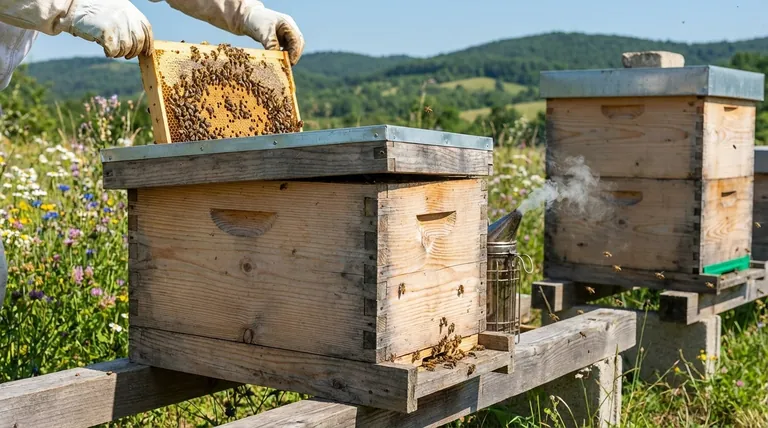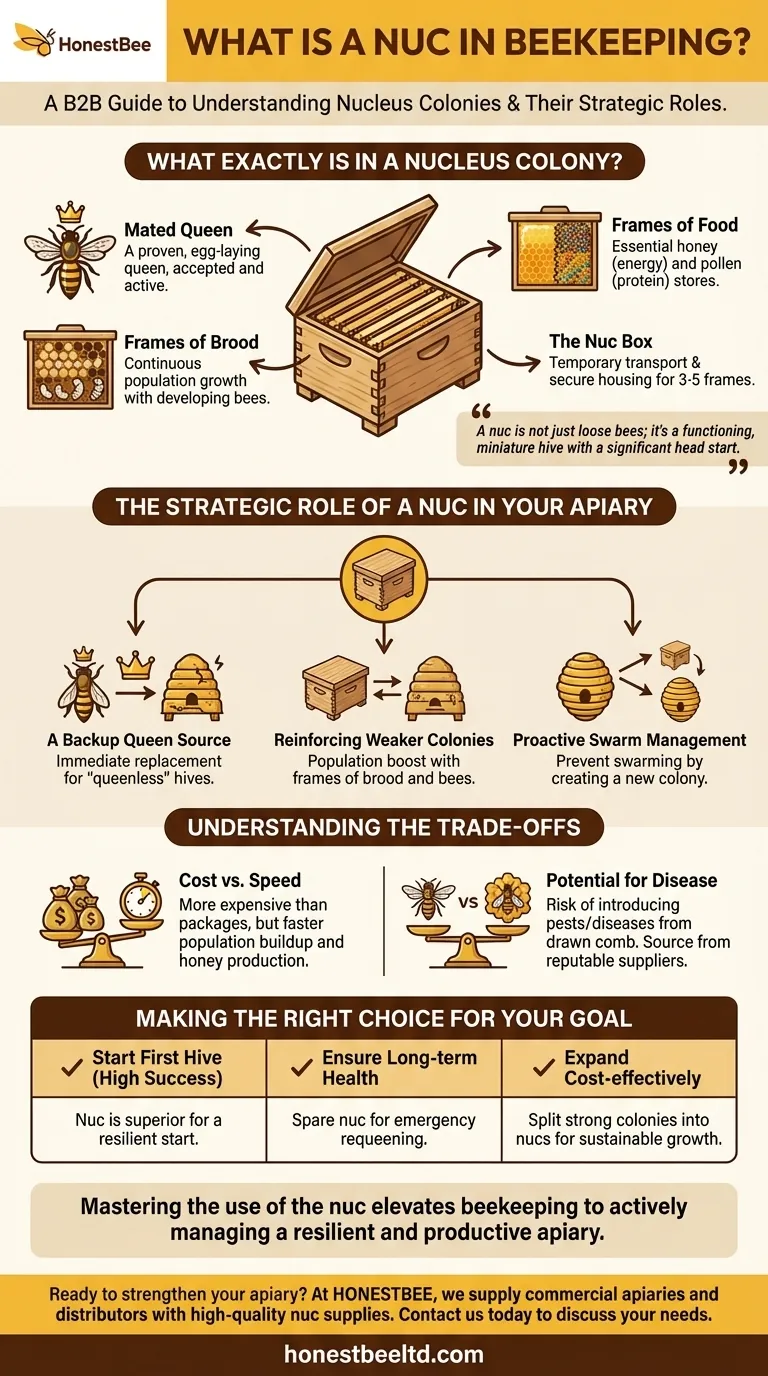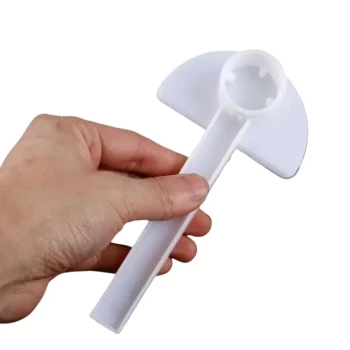In beekeeping, a 'nuc' is a small, established starter colony of bees. Short for "nucleus colony," it is not just a box of loose bees; it's a functioning, miniature hive. A typical nuc contains a mated and accepted queen, worker bees, and several frames of brood (developing bees), honey, and pollen, all housed in a small, temporary box.
A nuc is more than just a way to start a new hive. For the serious beekeeper, it is a fundamental management tool used for queen replacement, population support, and swarm control.

What Exactly is in a Nucleus Colony?
A nuc provides all the essential components of a healthy hive, giving the colony a significant head start when transferred into full-sized equipment.
The Mated Queen
The core of the colony is a proven, egg-laying queen. Because she is already accepted by the worker bees and actively laying, the colony can begin to expand its population immediately.
Frames of Brood
A quality nuc will contain multiple frames with brood in all stages—eggs, larvae, and capped pupae. This is the clearest sign of a healthy queen and ensures a continuous supply of new bees will emerge in the coming weeks.
Frames of Food
The frames also include stored resources like honey (for energy) and pollen (for protein). This built-in food supply sustains the colony as it gets established in its new home, reducing initial stress.
The Nuc Box
The colony itself is housed in a small box, typically holding three to five frames. This is temporary housing designed for transport and to keep the small colony warm and secure until it can be moved into a standard hive body.
The Strategic Role of a Nuc in Your Apiary
While beginners often buy a nuc to start their first hive, experienced beekeepers use them for a variety of essential management tasks.
A Backup Queen Source
Disaster can strike a full-sized hive at any time, leaving it "queenless." Having a nuc on hand provides an immediate replacement queen and frames of brood to save the failing colony.
Reinforcing Weaker Colonies
If one hive is struggling, frames of brood and bees can be taken from a strong nuc and given to the weaker colony. This population boost can often be the critical factor that helps it recover and thrive.
Proactive Swarm Management
When a strong hive becomes overcrowded, its natural instinct is to swarm, which means you lose half your bees. You can proactively prevent this by "splitting" the hive, moving the old queen and a few frames of brood into a nuc to create a new, smaller colony and relieve congestion in the parent hive.
Understanding the Trade-offs
While incredibly useful, it's important to understand the context of using a nuc.
Cost vs. Speed
Purchasing a nuc is typically more expensive than buying a "package" of bees (a loose swarm with a caged queen). However, a nuc will build up its population and produce honey much faster because it is already an established colony.
Potential for Disease
Because a nuc includes drawn-out comb from another beekeeper's apiary, it carries a small but real risk of introducing pests or diseases. It is absolutely critical to source your nucs from a reputable, registered, and trusted local supplier.
Making the Right Choice for Your Goal
How you use a nuc depends entirely on your objectives as a beekeeper.
- If your primary focus is starting your first hive with the highest chance of success: A nuc is the superior choice, as it gives you a resilient, functioning colony from day one.
- If your primary focus is ensuring the long-term health of your apiary: Maintaining a spare nuc is a key strategy for emergency requeening and hive support.
- If your primary focus is expanding your number of hives cost-effectively: Learning to split your own strong colonies into nucs is the most sustainable way to grow.
Ultimately, mastering the use of the nuc is what elevates you from simply keeping bees to actively managing a resilient and productive apiary.
Summary Table:
| Component | Purpose |
|---|---|
| Mated Queen | A proven, egg-laying queen already accepted by the colony. |
| Frames of Brood | Ensures continuous population growth with eggs, larvae, and capped pupae. |
| Frames of Food | Provides honey and pollen to sustain the colony during establishment. |
| Nuc Box | Temporary housing for transport and security before moving to a full hive. |
Ready to strengthen your apiary with reliable nucleus colonies? At HONESTBEE, we supply commercial apiaries and beekeeping equipment distributors with the high-quality supplies needed to create and manage successful nucs. From durable nuc boxes to essential hive components, our wholesale-focused operations ensure you get the tools for resilient hive growth. Contact us today to discuss your needs and elevate your beekeeping management.
Visual Guide

Related Products
- 5 Frame Wooden Nuc Box for Beekeeping
- Automatic Heat Preservation 6 Frame Pro Nuc Box for Honey Bee Queen Mating
- 4 Frame Plastic Nuc Boxes for Beekeeping Bee Nuc Box
- 5 Frame Langstroth Poly Nuc Corrugated Plastic Nuc Boxes
- Honey Flow Garden Bee Hive Flow Hive Best Beehive for Beginners
People Also Ask
- What are the benefits of moving nuclei around the apiary? Master Strategic Hive Management
- How many frames does a typical wooden nuc box hold? A Guide to Choosing the Right Size
- What is a common feature of many 5-frame nuc boxes? The Integrated Feeder for Efficient Colony Growth
- What is the most common type of standard nuc? The 5-Frame Nuc Explained
- What is the advantage of overwintering a nucleus? A Strategic Asset for Beekeeping Success



















